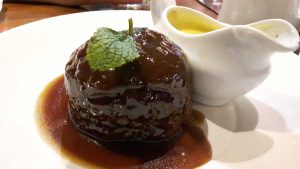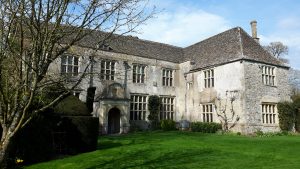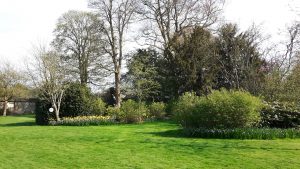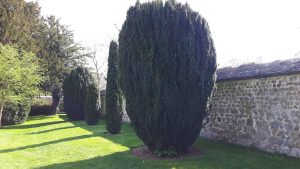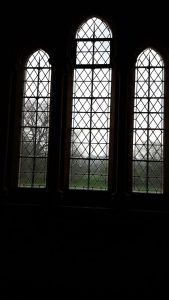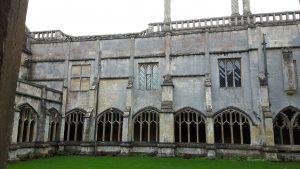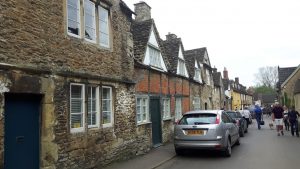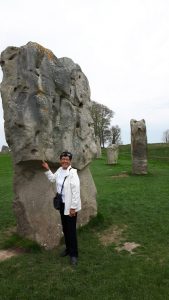Day 13
Our last day for touring. We packed our cases into the car and headed out to Lacock Abbey, Chippenham. There are several fascinating stories about Lacock Abbey. We learned that it is best known because of its last owner William Henry Fox Talbot. But perhaps I should start with the first owners.
William Fitz-Patrick (2nd Earl of Salisbury) owned Lacock. When he died, Ela, his nine-year-old daughter, inherited her father’s title, fortune, and lands. As an heiress, Ela came under the protection of the King- Richard-the Lion Heart. King Richard arranged the marriage of his young ward to his half-brother, William Longespée. William and Ela had eight children. Ela’s husband died in 1226. Ela was only 39 years old. She took over his role as Sheriff of Wiltshire temporarily but was later appointed as Sheriff in her own right. All of the couple’s wealth, land and title reverted to her. From this time, she started planning the founding of what was to become Lacock Abbey. By 1229 she took the first step of giving land at Lacock to the church.
On April 16th, 1232, Ela laid the foundation stone of Lacock Abbey, and the building commenced. Ela joined Lacock Abbey as a nun in 1238.
The convent closed in 1539 as part of the dissolution of the monasteries. We saw significant parts of the Abbey that Ela had built and visited what had been Ela’s bedroom; we walked the cloisters. We had to tread carefully in some of the rooms on the main floor because of extremely uneven and crumbling stones.
The last owner of Lacock was ‘William Henry Fox Talbot FRS February 11th, 1800 – September 17th 1877. He was a British scientist, inventor and photography pioneer who invented the salted paper and calotype processes, precursors to photographic processes of the later 19th and 20th centuries.’ Source: Wikipedia
His work and contribution to science and photography are exhibited in the museum with great detail, through pictures. An incredible display of cameras dating from the beginning of photography to the present are also on display.
Lacock Village has been used as a film and television location many times, notably for the 1995 production of Pride and Prejudice and, who, may I ask, will ever forget Colin Firth as Mr. Darcy? Of course, that would only count if you have seen the series. Also, the 2007 BBC production of Cranford was filmed in the village. Scenes for the Harry Potter movies were shot in the Abbey, classroom scenes, laboratory scenes, and many more. As well in 2015, it was used for a series of Downton Abbey episodes.
It would be almost sacrilegious, not to visit a café in any of these intriguing and stately dwellings of England, so after viewing the Abbey, we crossed the cobbled courtyard to the tea-room, which in times gone by had been stables. Entering the tea-room. We ordered our lunch and sat down at one of the tables—each one set with bone china cups and saucers.
Hilary had conferred with David, and he agreed we should visit Avebury before continuing on to Heathrow. The day was hot-pleasantly hot. We strolled to the museum, which had been a seventeenth-century threshing barn. The helpful staff gave us information about the layout of Avebury.
Recognised as a World Heritage Site for it’s outstanding Neolithic and Bronze Age landscape, Avebury is a place where you can connect with history and take time to imagine what life might have been like thousands of years ago. The stone circles and henge monument are particularly unusual, not just because it is the largest stone circle in the world but also for the fact that it is the only stone circle with a village built within it. Source: National Trust website
Needless to say, we walked around the henge and wondered how Neolithic man ever erected those huge stones in a complete circle.
The henge at Avebury is exceptionally large at just over three quarters of a mile in circumference and it would have been originally up to 29 feet deep. The large outer stone circle contains two smaller inner circles within it. The stones themselves are of a local sarsen stone. Source: National Trust website
The Manor House at Avebury
Through the BBC television series ‘The Manor Reborn,’ we knew that for many years the manor had stood vacant and uncared for. Restoration occurred as a team of experts returned the house to its past splendour. Nine rooms were restored, reflecting Tudor, Georgian, Edwardian, and early 20th century periods.
Hilary and I sat at the table in the Tudor dining room. Needless to say, more pictures were taken. The Queen Anne bedroom on the second floor was beautiful to behold. We learned the room had been prepared for the Queen, but she never did make it to the house. Anne had a loving relationship with her husband, Prince George. Still, their marriage was saddened by Anne’s twelve miscarriages and the fact that none of their other five children reached adulthood.
We traversed the walled vegetable garden, which was bereft of much growth, but plants were promising better days ahead. The topiary gardens were lush and green, and here we took more pictures before buying a few items in the gift shop.
Back in the car, as we buckled our seat belts, I remembered I had left my cell phone in the gift shop. Oh No! Fearless Hilary, without further ado, told us to wait while she went to retrieve it, and I might add, it was a long trek back to that shop! But back she came waving victoriously!
As we drove to Heathrow to board our flight back to Canada. I thought about Wordsworth, whose heart was filled with pleasure when he gazed upon the daffodils of England, and Browning, who longed to be there when April arrived. I too can relate to the emotions aroused when seeing all that beautiful Britain
has to offer.
+

